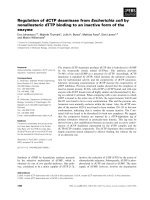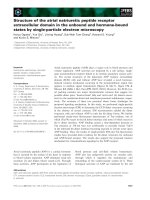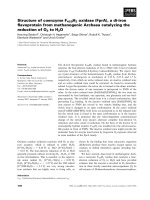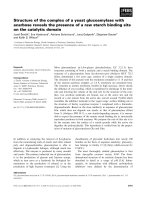Báo cáo khoa học: Structure of the polysaccharide chain of the lipopolysaccharide from Flexibacter maritimus pptx
Bạn đang xem bản rút gọn của tài liệu. Xem và tải ngay bản đầy đủ của tài liệu tại đây (241.12 KB, 6 trang )
Structure of the polysaccharide chain of the lipopolysaccharide
from
Flexibacter maritimus
Evgeny Vinogradov
1
, Leann L. MacLean
1
, Elizabeth M. Crump
2
, Malcolm B. Perry
1
and William W. Kay
2
1
Institute for Biological Sciences, National Research Council, Ottawa, Ontario, Canada;
2
Department of Biochemistry and
Microbiology, University of Victoria, Victoria, British Columbia, Canada
Flexibacter maritimus, a Gram-negative bacterium, is a fish
pathogen responsible for disease in finfish species and a cause
of cutaneous erosion disease in sea-caged salmonids. For the
development of serology based diagnostics, protective vac-
cines, and a study of pathogenesis, the structural analysis of
the lipopolysaccharide (LPS) produced by the bacterium has
been undertaken. We now report that an acidic O-specific
polysaccharide, obtained by mild acid degradation of the
F. maritimus LPS was found to be composed of a disac-
charide repeating unit built of 2-acetamido-3-O-acetyl-
4-[(S)-2-hydroxyglutar-5-ylamido]-2,4,6-trideoxy-b-glucose
and 5-acetamido-7-[(S)-3-hydroxybutyramido]-8-amino-
3,5,7,8,9-pentadeoxynonulopyranosonic acid (Sug) having
the structure:
The configuration of the C-2–C-7 fragment of the latter
monosaccharide (B) was assigned b-manno; however, the
configuration at C-8 could not be established. NMR data
indicate that the two monosaccharides have opposite abso-
lute configurations. The repeating unit includes a linkage via
a (S)-2-hydroxyglutaric acid residue, reported here for the
first time as a component of a bacterial polysaccharide. The
LPS was also found to contain a minor amount of a disac-
charide b-Sug-(2-3)-
L
-Rha, isolated from the products of the
acidic methanolysis of the LPS.
Keywords: Flexibacter maritimus; lipopolysaccharide; NMR;
polysaccharide.
The Cytophaga ) Flavobacterium ) Flexibacter bacteria
are a large, somewhat heterogeneous group of filamentous,
gliding, Gram-negative bacteria with unusual surface pro-
perties [1]. At least seven members of this group are
considered to be important fish pathogens. They infect a
wide variety of fish species and usually form filamentous
biofilms, primarily on the tissues associated with the oral
cavity. Among these, Flexibacter maritimus has recently
emerged as a cause of widespread severe mortality and
economic losses in farmed marine species worldwide [2].
F. maritimus, a long rod-shaped, Gram-negative bacter-
ium, has been associated with disease (Flexibacteriosis) in a
number of fish species [3–5] and its economic importance
has been related to a cause of cutaneous erosion disease
particularly in sea-caged salmonids [6,7]. In grouper,
F. maritimus causes Ôred boilÕ disease [8] related to its clinical
signs of reduced scales and severe hemorrhage on the body
surface, resembling boiled skin and causing a high mortality
rate. No effective vaccine has been developed against this
pathogen.
A clearer definition of the relevant immunoreactive
macromolecules of these bacterial fish pathogens is funda-
mentally important particularly with regard to the mecha-
nisms of pathogenesis and the role of infective biofilms. This
information is important for the development of appropri-
ate immunochemical reagents to facilitate speciation and the
design of cost-effective, efficacious vaccines.
Lipopolysaccharides (LPS, endotoxins) play a role in the
pathogenesis of Gram-negative infections and the structural
analysis of their antigenic LPS O-polysaccharide (O-PS)
components is important in providing a molecular level
understanding of their serological specificities, role in
pathogenesis, development of diagnostic agents, and the
production of O-PS based conjugate vaccines. As part of a
study of bacterial fish infections, this paper records the
determination of the unusual structure of the LPS O-PS-
antigen of F. maritimus.
Experimental procedures
Bacterial cell growth and LPS and O-PS production
F. maritimus was grown in a 35-L Chemap fermenter
(Chemap AG, Volketswil, Switzerland) in 30 L MAT made
in an Instant Ocean (Aquarium Systems, Mentor, OH, USA)
at 25 °C, stirring at 300 r.p.m., aeration rate of 15 LÆmin
)1
,
for 42 h. Cells were collected by low speed centrifugation and
Correspondence to M. B. Perry, Institute for Biological Sciences,
National Research Council, Ottawa, Ontario, Canada K1A 0R6.
Fax: + 1 613 941 1327, Tel.: + 1 613 990 0837.
E-mail:
Abbreviations: LPS, lipopolysaccharide; O-PS, O-polysaccharide;
S-LPS, smooth LPS; R-LPS, rough LPS; DOC/PAGE, deoxycholate
polyacrylamide gel electrophoresis.
(Received 6 November 2002, revised 13 February 2003,
accepted 26 February 2003)
Eur. J. Biochem. 270, 1810–1815 (2003) Ó FEBS 2003 doi:10.1046/j.1432-1033.2003.03543.x
the cell pellet (355 g) was washed with 0.9% NaCl and
extracted with stirred 50% aqueous phenol (400 mL) for
10 min at 60–70 °C. Following low speed centrifugation of
the cooled (4 °C) extract to remove solid material, the clear
phenol and water phases were collected separately and
dialysed against running tap water until they were free from
phenol. The lyophilized retentates were dissolved in 35 mL
10 m
M
Tris pH 8.0 and treated sequentially with DNase and
RNase for 3 h at 37 °C, followed by proteinase K(Sigma) for
a further 6 h. The digests were dialysed against distilled water
and ultracentrifuged at 105 000 g (4 °C) for 10 h to yield
LPS as gel pellets (yields: 910 mg water phase, 290 mg PhOH
phase) which were dissolved in distilled water and lyophi-
lized. DOC/PAGE (13%) revealed that the water phase
extract contained essentially smooth LPS (S-LPS) and the
phenol phase rough LPS (R-LPS).
Aqueous phase S-LPS (0.4 g) in 2% (v/v) acetic acid
(100 mL) was kept at 100 °C for 2 h and following low
speed centrifugation to remove precipitated Lipid A
(61 mg), the lyophilized centrifugate dissolved in pyridinium
acetate buffer (pH 4.5, 5 mL), was fractionated by Sepha-
dex G-50 column chromatography (2.5 · 90 cm) using the
same buffer as the eluant. The high molecular mass O-PS
fraction (K
av
, 0.02–0.15) of the eluant was lyophilyzed
(218 mg). The O-PS had [a]
D
)60° (c.0.2,water)andwas
used in all further analyses.
NMR spectroscopy and general methods
1
Hand
13
C NMR spectra were recorded on a Varian Inova
500 spectrometer in D
2
Oat25°C with acetone standard
(2.225 p.p.m. for
1
H and 31.5 p.p.m. for
13
C) using
standard pulse sequences COSY, TOCSY (mixing time
120 ms), NOESY (mixing time 250 ms), HSQC, gHMBC
(optimized for 5 Hz long range coupling constant). GLC,
GLC-MS, electrospray MS, monosaccharide and chemical
analyses were performed as previously described [9].
Preparation of oligosaccharides 1 and 3
O-PS (60 mg) or LPS (200 mg) were suspended in dry
methanol (3 or 6 mL, respectively), cooled in a dry ice/
acetone bath, and acetyl chloride (0.2 or 0.4 mL) was added
and the dissolved material were kept at 80 °C for 24 h.
Followed by drying in an air stream, the products were
separated by HPLC on a C18 column (Phenomenex Aqua,
0.9 · 25 cm) in 2% MeCN in water. Compound 3was eluted
ahead of compound 1 (from LPS), the a-andb-anomers of 1
were not separated under these conditions: Yield of 1,23 mg
from O-PS, 38 mg from LPS; yield of 3, 3 mg from LPS.
The acetate derivative 2 was prepared by treatment of 1
(60 mg) with Ac
2
O/Py (1 : 1 v/v, 6 mL) at 100 °Cfor1h,
concentration by drying under air flow, and fractionation
on the HPLC system described using a 10–100% MeCN
gradient to yield 2 (56 mg).
Characterization of (
S
)-3-hydroxybutanoic acid
and (
S
)-2-hydroxyglutaric acid substituents
O-PS (15 mg) was hydrolysed with 2
M
HCl (0.2 mL,
100 °C, 4 h), and, after concentration in a nitrogen stream,
the solution of the residue in water was passed through
Dowex (H
+
)50W· 8–200 ion-exchange resin to remove
basic materials and the concentrated eluate was subjected to
1
H NMR identification and analysis according to the
directions of the Sigma b-hydroxybutyrate dehydrogenase
diagnostic system kit (procedure no. 310 UV) [10]. (S)-2-
hydroxyglutaric acid released by methanolysis (M MeOH/
HCl, 100 °C, 16 h) and characterized by GLC of its
O-trimethylsilylated (S)-2-butyl ester derivative as described
previously [11,12]. Authentic standards of optically active
acids were from Sigma.
Results and discussion
Fermenter grown cells of F. maritimus were extracted by hot
aqueous phenol and yielded S-LPS and R-LPS, obtained as
precipitated gels after ultracentrifugation of the aqueous
and phenol phases respectively. DOC/PAGE analysis
showed the S-LPS product to give silver stained ladder
bands indicative of the LPS being composed of disaccharide
repeating units forming a high molecular mass O-PS of a
restricted mass range [13].
The O-PS was isolated from the S-LPS of F. maritimus by
mild acid hydrolysis followed by Sephadex G50 gel-
filtration chromatography. No monosaccharides were iden-
tified by GLC analysis of reduced and acetylated products
from the use of conventional acid hydrolysis conditions.
NMR analysis of the polysaccharide using
1
H,
13
C,
2D-COSY, TOCSY, NOESY, HSQC, HSQC-TOCSY,
and HMBC spectra led to the complete assignment of all
1
Hand
13
C signals and observed correlations, as presented
in Table 1. These data revealed the presence of the spin
systems of 2,4-diacylamino-2,4,6-trideoxy-b-glucopyranose
(A), 3-hydroxybutyrate (Bu), 2-hydroxyglutarate (C), and
5,7,8-triamino-3,5,7,8,9-pentadeoxynonulosonic acid (B).
The positions of the amino groups were determined from
the chemical shifts of the carbon atoms linked to nitrogen at
46.5–56.3 p.p.m. (Fig. 1). The position of N- and O-acyl
groups was determined from three experiments: (a) in the
HMBC spectrum, the carboxyl carbon of each acyl group
gave a cross peak with the proton at the acylation position;
(b) the H-2 (H-4 in case of 2-hydroxyglutaric acid residue) of
the acyl residues gave a NOE to the respective protons at the
acylation position; (c) NOEs measured in 9 : 1 H
2
O/D
2
O
solution showed correlations between the amide protons and
H-2 of acyl groups (Fig. 2). Additionally, O-acetylation at
O-3 residue A is supported by the low field position of A-3
1
H
signal at 5.02 p.p.m. Pyranosidic ring size of residues Aand B
follows from the absence of other possibilities for ring size.
The b-gluco-configuration of residue A followed from
measured vicinal coupling constants (Table 1). The confi-
guration of the nonulosonic acid residue B was determined
on the basis of interproton coupling constants and NOE
data. The orientation of the substituents at C-4 and C-5 of
residue B follows from measured coupling constants: a
large coupling 13 Hz between H-3ax and H-4 indicated
the axial position of H-4. Small coupling constants J
4,5
and J
5,6
< 5 Hz indicated an equatorial orientation of
H-5. A large coupling J
6,7
¼ 10.2 Hz corresponds to a
trans-orientation of the H-6 and H-7 protons. A strong
NOE observed between NH-7 and H-5 is only possible in
the case of a manno-configuration of the C-4–C-7 fragment,
as confirmed by molecular modelling
INSIGHT II
-
DISCOVER
Ó FEBS 2003 Polysaccharide structure of F. maritimus LPS (Eur. J. Biochem. 270) 1811
(MSI-Accelrys). Futher NOEs observed between NH-5 and
H-3ax, and between NH-5 and H-7, were also consistent in
molecular modelling of the monosaccharide having a
manno-configuration. Data establishing the configuration
at C-8 was not obtained.
The anomeric configuration of the nonulosonic acid (B)
was deduced from the position of the H-3 proton signals. As
shown previously for nonulosonic acids with the manno-
configuration of the C-4–C-7 fragment, the chemical shift of
the H-3eq signal > 2.5 p.p.m. corresponded to an axial
orientation of the C-1 carboxyl group, and thus to the
b-configuration assigned [14].
The sequence of the component glycose residues were
determined from NOE and HMBC data. The H-1 of
residue A gave a NOE to H-4 and a HMBC correlation to
C-4 of residue B, thus proving the linkage of A-(1–4)-B.
HMBC correlation between C-2 of the nonulosonic
acid residue B and the H-2 of the 2-hydroxyglutaric acid
(residue C) indicated that residue B glycosylates C at the
O-2 position.
The
13
CNMRchemicalshiftoftheC-1ofresidueA had
the same value ( 100 p.p.m) as that previously published
for C-1 of b-
D
-QuiNAc in the b-
D
-QuiNAc-(1–4)-5-acet-
amido-7-formamido-3,5,7,9-tetradeoxy-
L
-glycero-a-
L
-manno-
nonulosonic acid fragment in the polysaccharide from
Pseudoalteromonas distincta [15]. This parameter is sensitive
to the combination of the absolute configurations of both
monosaccharides, and in the case of the Ps. distincta
polysaccharide it reflects different configurations of the
monosaccharides. The A-B-fragment of the O-PS from
F. maritimus is isosteric to that of Ps. distincta in the vicinity
of this glycoside bond and therefore must follow the same
rules for glycosylation effects. Thus it can be concluded that
residues A and B have different absolute configurations
(in the case of nonulosonic acid the absolute configuration
is referenced to C-7, the last chiral centre of the
Table 1.
1
H and
13
C-NMR Chemical shift and coupling data for the F. maritimus O-PS. OMe at B1 in 1, 3.91/56.0 p.p.m.; in 2, 3.83/54.0; in 3, 3.88/
55.8.
Residue Nucleus
1
J
1,2
(J
3ax,3eq
)
2 (3ax)/NH
J
2,3
(J
3ax,4
)
3 (3eq)
J
3,4
(J
3eq,4
)
4/NH
J
4,5
5/NH
J
5,6
6
J
6,7
7/NH
J
7,8
8/NH
J
8,9
9
A,PS
1
H 4.76 3.81/7.62 5.02 3.72/8.06 3.73 1.24
13
C 100.0 55.3 74.6 56.3 71.8 18.1
J, Hz 8.1 9.5 9.5 6.5
A,1
1
H 4.99 3.40 3.86 3.66 3.87 1.21 OMe 3.44
13
C 98.0 56.5 69.5 58.7 69.0 18.7 57.3
A,2
1
H 4.68 4.33/6.32 5.15 3.85/6.99 3.93 1.25 OMe 3.34
13
C 99.1 52.4 73.8 56.1 66.3 18.6 56.0
B,PS
1
H 1.82 2.64 3.98 4.32/8.38 4.01 4.15/8.11 3.59/7.82 1.31
13
C 173.4 103.6 36.0 74.2 46.5 74.2 51.7 50.3 14.5
J, Hz 12.8 12.8 < 3 < 3 < 3 10.2 8.5 6.5
B,1
1
H 1.89 2.74 4.14 3.54 4.08 4.45 3.61 1.41
13
C 170.6 102.5 35.7 64.6 51.8 72.4 51.7 48.9 12.9
J, Hz 13.4 13.4 5.0 3.8 0 10.7 2.7 6.9
B,2
1
H 1.84 2.39 4.84 4.45/6.85 3.78 4.34/6.24 4.37/6.61 1.17
13
C 168.7 100.4 31.5 68.8 45.5 74.0 52.4 47.0 15.6
B,3
1
H 1.83 2.80 4.14 3.54 3.92 4.43 4.03 1.41
13
C 170.9 100.3 35.9 64.7 51.8 72.3 52.0 49.3 13.6
C,PS
1
H 4.12 1.88 2.27
13
C 179.1 75.5 30.0 32.6 177.0
C,1
1
H 4.37 2.02 2.36 OMe 3.83
13
C 176.4 75.2 30.0 32.3 177.0 55.1
C,2
1
H 4.41 1.93; 2.19 2.35 OMe 3.77
13
C 173.8 72.6 29.3 32.3 173.0 53.2
D,3
1
H 4.64 3.63 4.13 3.51 3.72 1.30 OMe 3.38
13
C 102.6 70.3 75.9 72.1 70.4 18.8 56.9
Bu, PS
1
H 2.34; 2.43 4.18 1.22
13
C 175.4 46.3 66.0 23.3
Bu, 1 and 3
1
H 2.46; 2.59 4.25 1.24
13
C 178.9 46.3 67.0 24.3
Bu, 2
1
H 2.38 5.25 1.29
13
C 171.1 44.6 68.9 21.2
N-Ac at A2
1
H 1.93
13
C 175.4 23.4
O-Ac at A3
1
H 2.01
13
C 174.5 21.2
N-Ac at B7
1
H 1.97
13
C 23.2 175.4
1812 E. Vinogradov et al. (Eur. J. Biochem. 270) Ó FEBS 2003
manno-fragment). Since the residue of 2,4-diamino-
2,4,6-trideoxyglucose (bacillosamine) has only been
found in the
D
-configuration [9,16–20], we tentatively present
it as
D
-, and therefore the nonulosonic acid derivative B in
the
L
-configuration.
Acidic methanolysis of the O-PS gave a high yield of
disaccharide 1 (isolated by reverse-phase HPLC, it contained
20% b-anomer). NMR analysis showed 1 to represent the
repeating unit of the O-PS lacking both N-acetyl and
O-acetyl substituents. Its structure was confirmed by elec-
trospray MS data ([M + 2]
2+
ion at m/z 326.8). Complete
acetylation of 1 gave derivative 2, prepared pure in a
significant amount ( 50 mg) (the b-anomer was removed
at this stage by HPLC) in the unrealized, but expected hope
of obtaining crystals for the determination of the configur-
ation of Sug by X-ray diffraction.
The absolute configuration of (S)-2-hydroxyglutarate
was determined by GLC of its O-trimethylsilylated
2-butyl ester derivatives prepared with optically pure
2-(S)-butanol, and the absolute configuration of the
(S)-3-hydroxybutyrate substituent was established from
the negative reaction of the liberated acid in the enzymic
D
-3-hydroxybutyric dehydrogenase analytical procedure
[10].
The combined experimental data led to the following
structure of the O-PS repeat unit:
Acidic methanolysis of intact LPS gave, in addition to
disaccharide 1, a minor amount of disaccharide 3 in
which the nonulosonic acid residue was linked to the O-3
position of a rhamnose unit. This product originated
from the LPS core or was present as a single unit lost
from the O-PS during mild hydolysis. LPS showed the
presence of Rha in a similar amount to those of GlcN,
Glc and Man: each of these monosaccharide constituted
0.5–1.5% by weight of the LPS. Rhamnose was not
present in the isolated O-PS.
Fig. 1.
1
H-
13
CHSQCspectrumofF. maritimus O-PS. The anomeric signal of residue A in the
1
H NMR spectrum resides under the water
signal.
Ó FEBS 2003 Polysaccharide structure of F. maritimus LPS (Eur. J. Biochem. 270) 1813
Nonulosonic acids have been found in natural
sources in three major variants: 5-amino-3,5-dideoxy-
D
-glycero-
D
-galacto-nonulosonic acid (neuraminic acid),
3-deoxy-
D
-glycero-
D
-galacto-nonulosonic acid (Kdn) and
5,7-diamino-3,5,7,9-tetradeoxy-nonulosonic acids. The
latter class was found in four configurations:
L
-glycero-
L
-manno (pseudaminic acid),
D
-glycero-
D
-galacto (legio-
naminic acid),
L
-glycero-
D
-galacto (8-epi-legionaminic
acid), and
D
-glycero-
D
-talo (4-epilegionaminic acid)
[12,21]. All of these monosaccharides can have variable
N- and O-acyl substituents and other modifications.
O-PS from Flexibacter, described herein, contains a new
nonulosonic acid derivative, 5-(3-hydroxybutyramido)-7-
acetamido-8-amino-3,5,7,8,9-pentadeoxy-b-manno-nonulo-
pyranosonic acid, with as yet undetermined configuration
at C-8 and tentatively assigned the
L
-absolute configur-
ation. Biosynthesis of sialic acids and possibly 5,7-
diamino-3,5,7,9-tetradeoxy-nonulosonic acids proceeds
by condensation of hexose derivatives with phosphoenol-
pyruvate, so that atoms C1–C6 of the hexose become
C4–C9 of the nonulosonic acid. As in the 5,7,8-triamino-
3,5,7,8,9-pentadeoxynonulopyranosonic acid position 8,
which would be C-5 in a possible hexose precursor, is
occupied by an amino group, its biosynthesis must be
different from that of other nonulosonic acids or include
an introduction of the amino group following the
condensation step.
The O-PS of F. maritimus contains a linkage involving a
(R)-2-hydroxyglutaric acid residue reported here for the first
time as a bacterial polysaccharide component. A similar
component, O-glycosylated amide linked (R)-malic acid was
recently reported as a component of the O-PS from another
fish pathogen Flavobacterium psychrophilum [9].
The structural differences exhibited by the O-PSs from
F. maritimus and Fl. psychrophilum [9] are reflected in the
observed serological specificities shown by rabbit antisera
prepared against synthetic respective O-PS glycoconjugates
(unpublished data) and their use as diagnostic agents and
Fig. 2. Partial NOESY spectrum of F. maritimus O-PS (H
2
O/D
2
O, 9 : 1) showing correlations from NH-protons.
1814 E. Vinogradov et al. (Eur. J. Biochem. 270) Ó FEBS 2003
possible vaccines. It is also interesting that the prolific
production of the O-PS of these species probably contri-
butes to the surface properties and consequent biofilming
characteristics of these pathogens, especially in the case of
F. maritimus.
Acknowledgements
This work was supported by the Canadian Bacterial Diseases Network.
References
1. Bernadet, J.F., Segers, P., Vancanneyt, M., Berthe, F.,
Kersters, K. & Vandamme, P. (1996) Cutting the Gordian knot:
emended classification and description of the genus Flavobacter-
ium, emended description of the family Flavobacteriaceae,and
proposal of Flavobacterium hydatis nom. nov, (Basonym, Cyto-
phaga aquatalis Strohl and Tait (1978). Int. J. Syst. Bacteriol. 46,
128–148.
2. Bernadet, J.F. (1997) Immunization with bacterial antigens:
Flavobacterium and Flexibacterium infections. Dev. Biol. Stand. 90,
179–188.
3. Handlinger, J., Soltani, M. & Percival, S. (1997) The pathology of
Flexibacter maritimus in aquaculture species in Tasmania, Aus-
tralia. J. Fish Dis. 20, 159–169.
4. Soltani, M., Munday, B.L. & Burke, C.M. (1996) The relative
susceptibility of fish to infections by Flexibacter columnaris and
Flexibacter maritimus. Aquaculture 410, 259–264.
5. Wakabayashi, H., Hikida, M. & Masumura, K. (1984) Flexibacter
infection in cultured marine fish in Japan. Helgolander Meere-
sunters 37, 587–593.
6. Schmidtke,L.,Carson,J.&Howard,T.(1991)MaineFlexibacter
infection in Atlantic salmon. Characterization of the putative
pathogen. In Proceedings of the SALTAS Research Review
Seminar, pp. 25–39. Hobart, Tasmania 22nd May 1991. Salmon
Enterprises of Tasmania (SALTAS) P/L, Hobart, Tasmania.
7. Danayadol, Y., Krachalwong, V., Ruangpan, L. & Direkbusar-
akom, S. (1996) Causative agent and control measure of red boil
disease in cultured grouper (Epinephelus malabaricus). Thai Fish-
eries Gazette 48, 29–35.
8. Ostland, V.E., LaTrace, C., Morrison, D. & Ferguson, H.W.
(1999) Flexibacter maritimus associated with bacterial stomatitis in
Atlantic salmon smolts reared in net-pens in, British Columbia.
J. Aquatic Health 11, 35–45.
9. MacLean,L.L.,Vinogradov,E.,Crump,E.M.,Perry,M.B.&
Kay, W.W. (2001) The structure of the lipopolysaccharide
O-antigen produced by Flavobacterium psychrophilum (259–93).
Eur. J. Biochem. 268, 1–8.
10. Williamson, D.H., Mellanby, J. & Krebs, H.A. (1962) Enzymic
determination of
D
-(-)-b-hydroxybutyric acid and acetoacetic acid
in blood. Biochem. J. 82, 90–96.
11. Shashkov, A.S., Paramonov, N.A., Veremeychenko, S.P.,
Grosskurth, H., Zdorovenko, G.M., Knirel, Y.A. & Kochet-
kov, N.K. (1998) Somatic antigens of pseudomonads: Structure
of the O-specific polysaccharides of Pseudomonas fluorescens
biovar B. strain IMV 247. Carbohydr. Res. 306, 297–303.
12. Perepelov, A.V., Babicka, D., Senchenkova, S.N., Shashkov, A.S.,
Moll, H., Rozalski, A., Za
¨
hringer, U. & Knirel. Y.A. (2001)
Structure of the O-polysaccharide of Proteus vulgaris O4 con-
taining a new component of bacterial polysaccharides, 4,6-di-
deoxy-4-{[N-[(R)-3-hydroxybutyryl]-
L
-alanyl}amino-
D
-glucose.
Carbohydr. Res. 331, 195–202.
13. Perry, M.B. & Babiuk, L.A. (1983) Structure of the polysaccharide
chains of Pasteurella haemolytica (serotype 4) lipopolysaccharide.
Can. J. Biochem. Cell Biol. 62, 108–114.
14. Tsvetkov, Y.E., Shashkov, A.S., Knirel, Y.A. & Za
¨
hringer, U.
(2001) Synthesis and NMR spectroscopy of nine stereoisomeric
5,7-diacetamido-3,5,7,9-tetradeoxynon-2-ulosonic acids. Carbo-
hydr. Res. 335, 221–243.
15. Muldoon, J., Shashkov, A.S., Senchenkova, S.N., Tomshich, S.V.,
Komandrova, N.A., Romanenko, L.A., Knirel, Y.A. & Savage,
A.V. (2001) Structure of the acidic polysaccharide from a marine
bacterium Pseudoalteromonas distincta. KMM 638 containing
5-acetamido-3,5,7,9-7-formamido-
L
-glycero-
L
-manno-nonulosonic
acid. Carbohydr. Res. 330, 231–239.
16. Hermansson, K., Perry, M.B., Altman, E., Brisson, J R. & Garcia,
M.M. (1993) Structural studies of the O-antigenic polysaccharide
of Fusobacterium necrophorum. Eur. J. Biochem. 212, 801–809.
17. Chowdhury,T.A.,Jansson,P.E.,Lindberg,B.,Gustafsson,B.&
Holme, T. (1991) Structural studies of Vibrio cholerae O: 3
O-antigen polysaccharide. Carbohydr. Res. 215, 303–314.
18. Knirel, Y.A., Vinogradov, E.V., Shashkov, A.S., Wilkinson, S.G.,
Tahara, Y., Dmitriev, B. A., Kochetkov, N.K., Stanislavsky, E.S.
& Mashilova, G.M. (1986) Somatic antigens of Pseudomonas
aeruginosa. The structure of O-specific polysaccharide chains of
the lipopolysaccharides from P. aeruginosa O1 (Lanyi), O3
(Habs), O13 and O14 (Wokatsch), and serologically related strains
NCTC 8505. Eur. J. Biochem. 155, 659–669.
19. Zubkov, V.A., Nazarenko, E.L., Gorshkova, R.P., Ivanova, E.P.,
Shashkov, A.S., Knirel, Y.A., Paramonov, N.A. & Ovodov, Y.S.
(1995) Structure of the capsular polysaccharide from Alteromonas
sp. CMM 155. Carbohydr. Res. 275, 147–154.
20. Young N.M., Brisson, J–R., Kelly, J., Watson, D.C., Tessier, L.,
Lanthier, P.H., Jarrell, H.C., Cadotte, N., St. Michael, F., Aberg,
E. & Szymanski, C.M. (2002) Structure of the N-linked glycan
present on multiple glycoproteins in the Gram-negative bacterium,
Campylobacter jejuni. J. Biol Chem. 277, 42530–42539.
21. Tsvetkov, Y.E., Shashkov, A.S., Knirel, Y.A. & Za
¨
hringer, U.
(2001) Synthesis and identification in bacterial lipopolysaccharides
of 5,7-diacetamido-3,5,7,9-tetradeoxy-
D
-glycero-
D
-galacto-and-
D
-
glycero-
D
-talo-non-2-ulosonic acids. Carbohydr. Res. 331, 233–237.
Ó FEBS 2003 Polysaccharide structure of F. maritimus LPS (Eur. J. Biochem. 270) 1815









